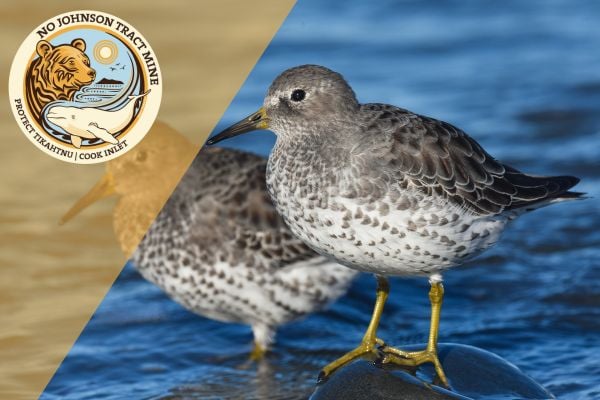Every spring, millions of birds sweep northward across Alaska’s skies, tracing ancient routes to their Arctic nesting grounds. Along the way, they rely on a handful of critical stopovers—shelterd places rich in food where they can rest and refuel.
Lake Clark National Park and its neighbor, Tuxedni Bay, are two of the most important of these pit stops on the Pacific flyway. Tuxedni bay is home to the Chisik National Wildlife Refuge, established by President Theodore Roosevelt in 1909 to protect the great seabird colonies that nest there. This refuge covers Chisik and Duck Island, and is home to the largest seabird colony in Cook Inlet | Tikahtnu.
Tuxedni Bay is also one of the most significant migration hubs in the Western Hemisphere, used by nearly every shorebird species that travels north each spring. Among them are Rock Sandpipers—roughly 30% of the world’s population, or about half a million birds, pause here each year. Unlike most migratory species, Rock Sandpipers head north during the winter months, and spend the cold months on the mudflats of upper Cook Inlet—making them some of the toughest travelers on the planet. When winter storms intensify, these tough little birds retreat to Tuxedni Bay, where there is a protected refuge to hunker down in.
But these resilient birds, and the countless others that depend on this region, are now threatened by the proposed Johnson Tract Gold Mine.
The Johnson Tract Mine would target a mineral-rich area at the base of Mt. Iliamna, inside the boundaries of Lake Clark National Park. The project site sits on a 20,942-acre private inholding owned by Cook Inlet Region, Inc. (CIRI), but its impacts would reach far beyond that parcel.
Plans include carving a 20-mile industrial access road through the park and building an industrial deep-sea port in Tuxedni Bay.
This coastline is far from barren—it’s alive with brown bears, millions of migratory birds, and Tuxedni bay represents the only known winter foraging ground for endangered Cook Inlet Beluga whales. An industrial port designed to handle up to 80 ore shipments a day would bring dredging, noise, and vessel traffic into what is now critical wildlife habitat. For bird populations already struggling due to habitat loss and climate change, such disruption could be devastating.
For migratory birds, Tuxedni Bay is like a roadside fuel stop—a place to eat, rest, and gather the energy they need to continue north.
Imagine driving with your gas gauge on empty, counting on a station at the next exit, only to find it bulldozed. You might make it to the next one—or you might not.
For birds, running out of fuel means starving mid-flight.
Destroying habitat in Tuxedni Bay could erase one of the few remaining “refueling stations” between the Pacific and Arctic, with deadly consequences for entire populations.
Tuxedni Bay supports roughly 30% of all Western Sandpipers and at least 10% of other migratory shorebird species in the Western Hemisphere. It also provides vital nesting and feeding grounds for raptors, waterfowl, and seabirds.
Seabird populations have plummeted nearly 70% worldwide since 1950—a drop driven by habitat disturbance, climate change, and invasive species. Yet Cook Inlet still holds some of the densest seabird colonies in Alaska, especially on Chisik and Duck Islands in Tuxedni Bay, where puffins, murres, guillemots, and glaucous-winged gulls still breed. The proposed mine would put this rare stronghold at risk.
The threats from the Johnson Tract Mine stretch far beyond the loss of wildlife. Birdwatchers from around the world flock to Cook Inlet each year, supporting Alaska’s tourism economy. For many Alaskans, these birds are a shared resource and cultural connection—a link to the rhythms of the land and sea, and, for traditional harvesters, a food source steeped in history.
Because so many of these species migrate thousands of miles, the effects of a mine in Alaska wouldn’t stay in Alaska. A disruption here could ripple across the continent, impacting bird populations—and ecosystems—from the Arctic tundra to the Gulf of Mexico.
Take Action for Tuxedni Bay
The threat to Tuxedni Bay is real—but it’s not inevitable.
At Cook Inletkeeper, we’re building a movement to stop the Johnson Tract Mine and protect the wildlife and communities that depend on Cook Inlet’s clean waters and wild shores.
The resistance starts with you.
Sign our petition, and join the effort to protect Tuxedni Bay—so that people, belugas, bears, and birds can continue to thrive, and Cook Inlet remains a refuge for generations to come.

